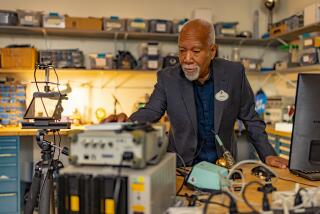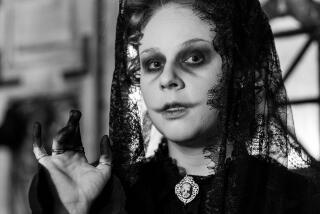Ex-Pilot Parlays Talent for Gadgetry Into Unique Firm : Voice-Operated Bookcase-Bars, Disappearing TV Sets, Rooms That Rotate, Secret Panels Are Company’s Forte
- Share via
At Dr. Ralph Venuto’s house in Laguna Niguel, turning on the television set will soon be an event in itself.
After opening the wooden doors on a custom-made cabinet to expose a seven-foot diagonal screen, the Newport Beach orthopedic surgeon will depress a button,and a platform holding the television projector unit will lower itself silently from the ceiling.
Next, Venuto will select one of the 150 channels his satellite dish can receive, and serious viewing will commence.
The television project is just part of an integrated electronic package that includes intercoms, sound systems throughout the house and electronic gates that can be operated through the telephone system.
All this is the work of a Mission Viejo company that specializes in electronic wizardry for houses and offices.
Rooms that rotate, secret panels, television sets that rise from tables, closed circuit television intercoms and voice-activated bookcases that rotate into bars are just a few of the creations of Unique Electronics, a company that owner Jim Walin has nurtured from a hobby into a $1-million business.
“James Bond stuff, that’s what we do,” said Walin.
As he recalls, the inclination to tinker with electronics began before he started school. “At an early age I was building Rube Goldberg contraptions,” said Walin, who after college worked his way up the general aviation ladder to a career as a pilot at Continental Airlines where he spent 12 years hauling passengers.
But even when Walin was a jumbo jet pilot, Rube Goldberg continued to walk in his shoes.
By 1975, his hobby had grown into a $15,000-a-year garage business, and Walin rented some workshop space with two associates. When Continental declared bankruptcy in 1983, Walin turned his hobby-job into his new career.
Given enough time and a deep enough budget, there is no electronic gizmo that Unique can’t make, Walin says.
An Orange County businessman, for example, wanted a glass-walled room in his custom-designed house that would rotate so he could gaze across Newport Harbor and then, without getting up or moving the furniture, look at the “media wall,” which includes a large television projection screen and stereo system.
Walin designed the room to rotate on a bed of rubber wheels that are driven by an electric motor coupled to a three-speed transmission.
Then there was a record producer who wanted a television set that would drop by the foot of his bed and then tilt 22%, the perfect angle for the weary executive’s eyes while he is propped up with pillows.
A ‘Fun Challenge’
Making the device that would tilt the set once it deployed was a “fun challenge,” Walin recalled. And just $5,300 later, the device worked as the executive wanted.
Businesses apparently also like electronic gadgetry.
An Orange County mortgage company, for example, commissioned Walin to install two secret doors that, when opened, reveal a bar and an audio-visual center. Then, at the push of a remote-control button, the equipment stows itself, the lights are turned out and the doors close.
Such devices also appeal to “neatness freaks,” Walin said.
For example, a recent customer wanted an uncluttered desk and hired Unique to do it electronically.
No problem.
Walin crafted a device that lifts the customer’s computer screen out of his desk when the keyboard is exposed. In another corner of the desk, a television set and a videotape recorder also rise and disappear at the command of a switch.
“They’re toys,” Walin said. “People like trick electronics.”
The “toys” can be costly.
Most systems take about three months to design, build and install. Unique has nine full-time employees and uses several subcontractors to do specialized computer, telephone, wood and metalwork.
Television deployment systems generally carry a price tag from $3,800 to $5,300 and it costs $30,000 to $50,000 to complete the typical electronically rigged house, which would have a hidden television set, intercom systems, stereo systems in each room and specialized cable and telephone systems. All of the systems are integrated through a main computer center.
However, it can cost twice that to really outfit a house in the finest electronics. Such a house would have satellite television systems, touch-operated heat, light and security systems and special effects, such as a secret door or two.
Walin’s ultimate project came in 1982 when the company outfitted an Orange County house with voice-activated systems that control every door and window, environmental controls activated by touch and speech and remote-control devices to control the array of systems in the house. The complete project cost nearly $200,000.
Rather than being just a lark for rich people, Walin reckons, “smart houses” will become more and more common.
“In the next five to 10 years we’ll see whole tracts built that will have lighting and heating control on a room-by room basis,” he said. “The energy saving alone would pay for the system in a year or two.”
In addition, such houses also will have electronic security systems and some special effects, such as devices to begin perking coffee before the owners arise for the day.
Despite the prices, demand for household and office electronics apparently is on a growth curve, Walin said, and he forecasts the company’s revenue will be 20% higher than last year.
More to Read
Inside the business of entertainment
The Wide Shot brings you news, analysis and insights on everything from streaming wars to production — and what it all means for the future.
You may occasionally receive promotional content from the Los Angeles Times.










